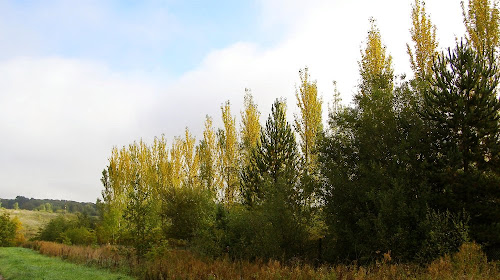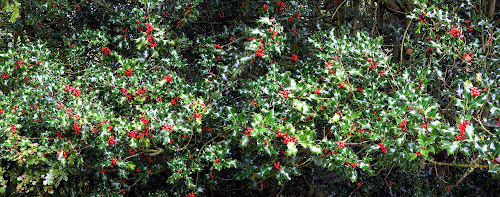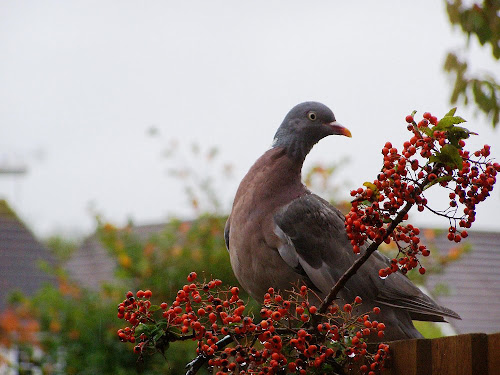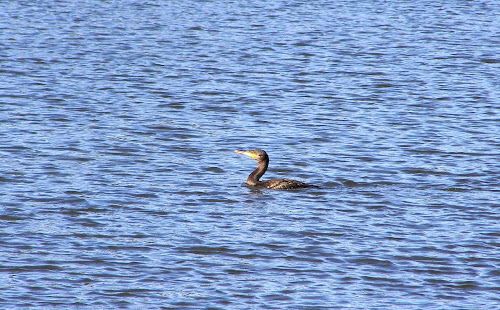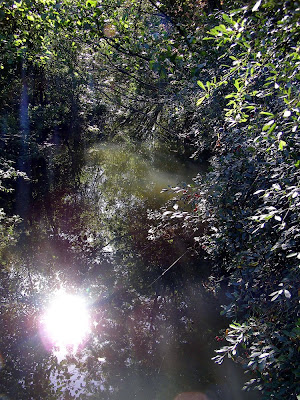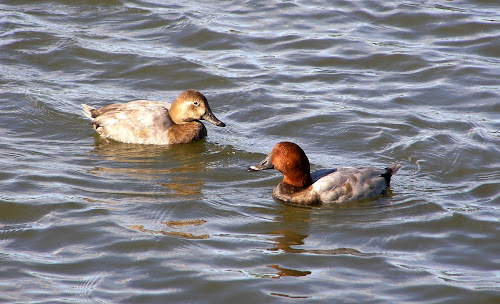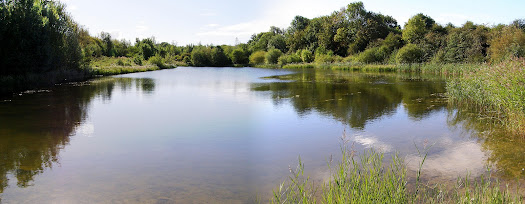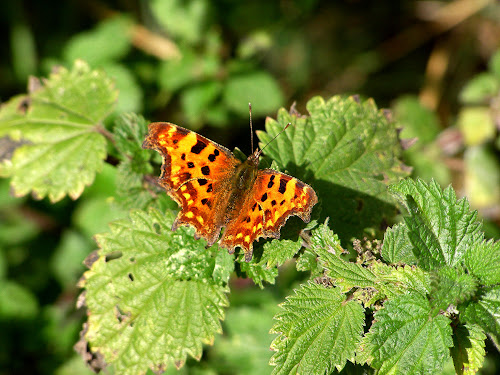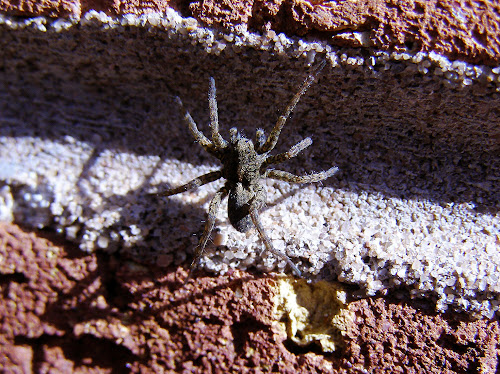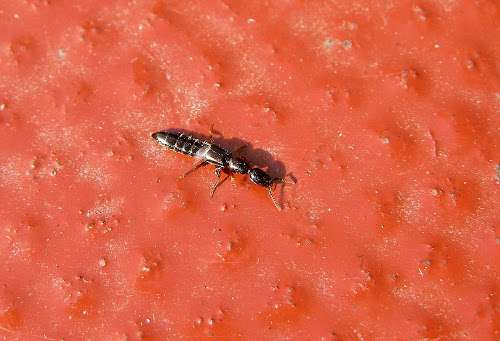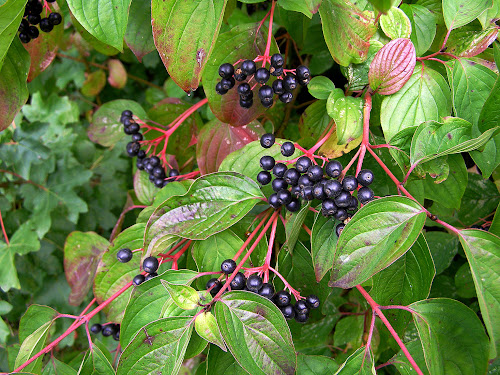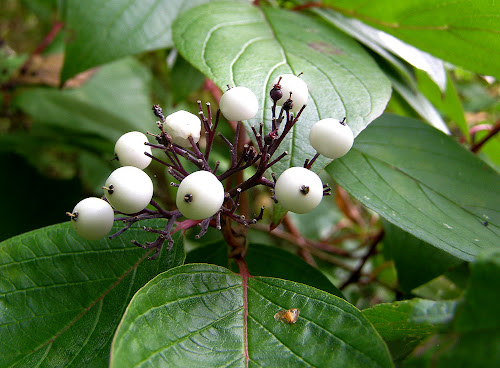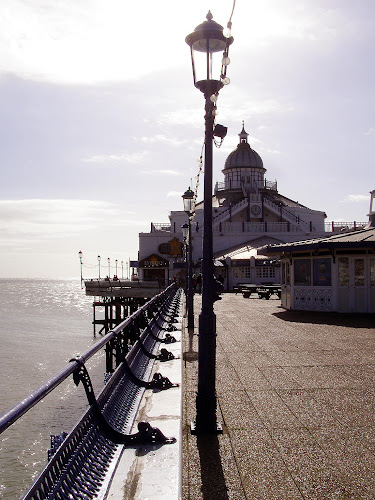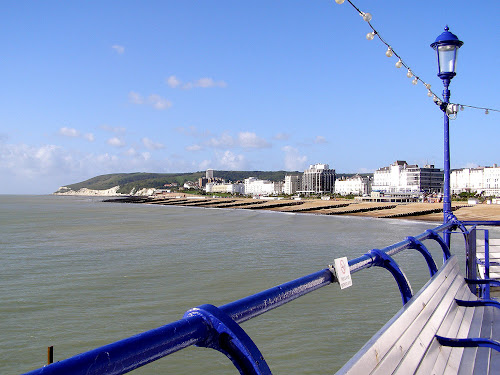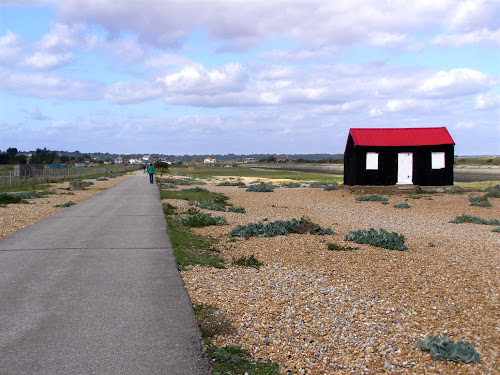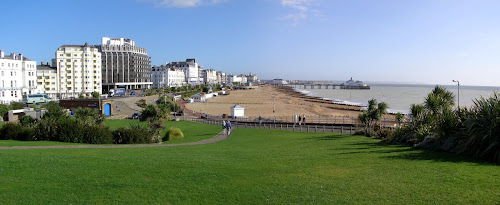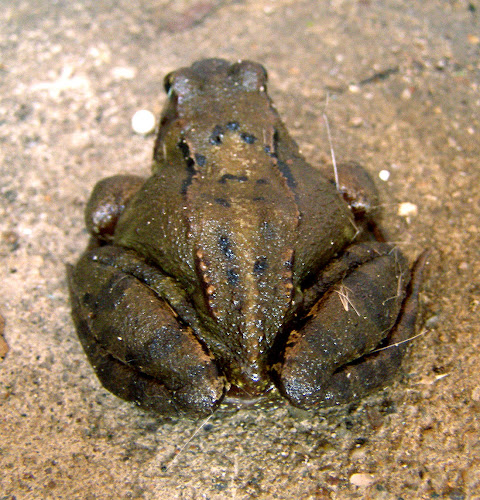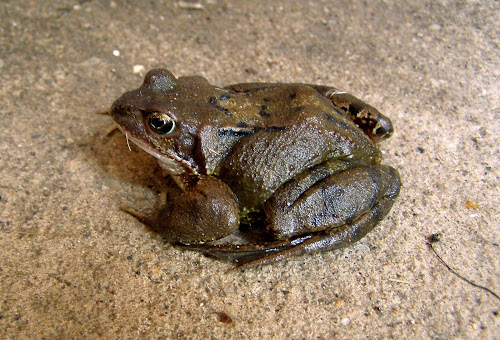Following our enforced lethargy over the past few days, it was nice to get out and about once again this morning. The sun shone brightly as I opened my eyes first thing, but by the time we had eaten breakfast and got ready to go out, it was misty, damp and dull again. The sun was still there (I think) but was having great difficulty trying to punch through the mist and low cloud.
When it did manage to find a way through, it illuminated the turning leaves beautifully.
It seems that the colours aren't quite as spectacular this year as they have previously been. I wonder if it is because we seem to have lurched straight from Summer into winter, thereby not giving the leaves time to develop their bright reds and yellows before they start to fall and rot. The line of Poplars around the old Theme Park lake, are one exception, almost glowing in the sunshine.
A reminder - if we needed one - that Christmas is only a few weeks away, is to be found in this large Holly tree, laden with berries.
The various members of the Acer family of trees, always give good value at this time of year. As the Chlorophyll begins to break down in the leaves, the other colours which are always present, begin to take over and show their true beauty.
It will not be long before the branches are bare and we are once again looking forward to seeing the first, pale shoots of Spring. But, lets get Christmas out of the way first! Now, "Dear Santa....."
Welcome to my blog. Don't expect anything too high-tech or flashy, this is simply a 'diary' to share some of my photos, thoughts and observations - with a particular bias towards the natural world and the countryside around my home.
Thursday 30 September 2010
Wednesday 29 September 2010
Miserable
What a miserable day! We got up this morning to find it was drizzling, grey and dull. Not conducive to a good walk in the countryside, so we decided to take a trip to Heanor to try to buy some 'fat-balls' for our little feathered friends. Getting a bit fed-up with this weather at the moment, but not as fed-up as the Woodpigeon (Columba palumbus) who was eating the berries from our Pyracantha this morning.
Woodpigeons are splendidly beautiful birds. They are our largest pigeon species as well as our most common. I particularly like the 'warm' and homely 'cooing' which they do. It always sounds like a 'comfortable' sort of sound. It is thought that there are between 2,500,000 and 3,200,000 breeding pairs of Woodpigeons in the UK. It was first scientifically classified by Carl Linnaeus (known as the "Father of Taxonomy"), in 1758. They always seem to have a look of surprise on their face.
Raindrops were beginning to fall heavier by the time we had finished our breakfast and the Pyracantha was dripping with wet jewels.
Lets hope the weather is better tomorrow...!
Woodpigeons are splendidly beautiful birds. They are our largest pigeon species as well as our most common. I particularly like the 'warm' and homely 'cooing' which they do. It always sounds like a 'comfortable' sort of sound. It is thought that there are between 2,500,000 and 3,200,000 breeding pairs of Woodpigeons in the UK. It was first scientifically classified by Carl Linnaeus (known as the "Father of Taxonomy"), in 1758. They always seem to have a look of surprise on their face.
Raindrops were beginning to fall heavier by the time we had finished our breakfast and the Pyracantha was dripping with wet jewels.
Lets hope the weather is better tomorrow...!
Monday 27 September 2010
Abbey
While watching TV last night, we were pleased to see a short piece about Fountains Abbey in Yorkshire.
It is more than two years since Malcolm and I went to Fountains on our way to a few days in Scotland. A riot at St Mary's Abbey in York led to the founding of Fountains Abbey in 1132 which, over the years became one of the richest religious organisations in the country through. It's wealth was due mostly to farming, mining, lead and iron-working, quarrying and horse-breeding. Financial mismanagement led to a severe downturn in Fountains' fortunes (some things never change).
The whole thing came to an abrupt end in 1539 with Henry VIII's dissolution and a year later, the lead and glass from the Abbey, was being used in Ripon and York.
In 1767, the site was sold for £18,000 to William Aislabie, who landscaped the ruins as a folly to be viewed from Water Gardens.
I took plenty of photos, as you can imagine and later, set some of them into a slide-show with some (appropriate?) music. Here it is....
It is more than two years since Malcolm and I went to Fountains on our way to a few days in Scotland. A riot at St Mary's Abbey in York led to the founding of Fountains Abbey in 1132 which, over the years became one of the richest religious organisations in the country through. It's wealth was due mostly to farming, mining, lead and iron-working, quarrying and horse-breeding. Financial mismanagement led to a severe downturn in Fountains' fortunes (some things never change).
The whole thing came to an abrupt end in 1539 with Henry VIII's dissolution and a year later, the lead and glass from the Abbey, was being used in Ripon and York.
In 1767, the site was sold for £18,000 to William Aislabie, who landscaped the ruins as a folly to be viewed from Water Gardens.
I took plenty of photos, as you can imagine and later, set some of them into a slide-show with some (appropriate?) music. Here it is....
Sunday 26 September 2010
Fisher
One of the things which caught our eye as we walked around the lakes of Straw's Bridge yesterday, was a large, black bird. It was swimming around and diving frequently after fish. It was of course a Cormorant (Phalacrocorax carbo). A common sight in Britain - and indeed over most of the world in one form or another - these goose-sized birds are famed for their fishing expertise. This one was difficult to photograph as it would dive below the surface every time I pointed the camera at it.
The Cormorant's plumage is rather special as it seems to be 'partially wetable' to assist in diving by reducing the birds' buoyancy. In some parts of the world, Cormorants are used by human fishermen to catch fish. Tame birds are taken out onto the water in a boat, tied around the neck with a chord tight enough to prevent the bird swallowing what it catches, then released into the water to chase the fish. They are very successful too - to which, anyone who has seen the HSBC advert will testify.
The hedgerows are becoming barer, especially after the few days of high winds this week. One plant which is probably at its best at this time of year has to be the Ivy (Hedera helix). Ivy is extremely important to late-flying insects as they start to flower in late summer and autumn, providing much-needed nectar for insects which would otherwise be bereft at this time.
I couldn't resist taking a picture of the sun glinting off the waters of the Nutbrook Canal. The light through the trees was almost magical as it sparkled through the darkness of the overhanging foliage.
A last splash of colour for today, from the fruits of a little-known tree of the British countryside. The Spindle (Euonymus europaeus) has curious, four-sectioned fruits which are very attractively pink coloured. It's common name comes from the fact that the very hard wood was used to make spindles for the wool making industry.
As attractive as the fruits are, they should be treated with care as they are very poisonous. Ingestion can result in liver damage kidney failure and even death.
The Cormorant's plumage is rather special as it seems to be 'partially wetable' to assist in diving by reducing the birds' buoyancy. In some parts of the world, Cormorants are used by human fishermen to catch fish. Tame birds are taken out onto the water in a boat, tied around the neck with a chord tight enough to prevent the bird swallowing what it catches, then released into the water to chase the fish. They are very successful too - to which, anyone who has seen the HSBC advert will testify.
The hedgerows are becoming barer, especially after the few days of high winds this week. One plant which is probably at its best at this time of year has to be the Ivy (Hedera helix). Ivy is extremely important to late-flying insects as they start to flower in late summer and autumn, providing much-needed nectar for insects which would otherwise be bereft at this time.
I couldn't resist taking a picture of the sun glinting off the waters of the Nutbrook Canal. The light through the trees was almost magical as it sparkled through the darkness of the overhanging foliage.
A last splash of colour for today, from the fruits of a little-known tree of the British countryside. The Spindle (Euonymus europaeus) has curious, four-sectioned fruits which are very attractively pink coloured. It's common name comes from the fact that the very hard wood was used to make spindles for the wool making industry.
As attractive as the fruits are, they should be treated with care as they are very poisonous. Ingestion can result in liver damage kidney failure and even death.
Saturday 25 September 2010
Nippy
After a couple of days watching the trees bend in the wind and struggle to hold on to their leaves, we awoke this morning to bright, blue skies and only a light breeze. The down-side to clear mornings, is the drop in temperature which has been so noticeable today. Our thermometer had dipped over night to 0.6°C - not far off a frost. All was clear and bright at the Straw's Bridge lakes too. Lots of parked cars at 'Swan Lake' indicated lots of crusts for the birds, among which was this pair of Pochards (Aythya ferina). The male Pochard was showing his gorgeous colouration and his glowing, red eye. His mate was - as is usual for water fowl - much more drab.
On another of the lakes, the family of Mute Swans (Cygnus olor) which have been in residence all year were swimming around. The cygnet, hatched back in June SEE HERE, is now almost as large as it's parents and beginning to lose it's grey-brown plumage.
It was a joy to walk around the lakes this morning with the sun shining on our backs and being out of the breeze. The lake which was the nursery for the Mute Swan above (although not today, as they occupied the lake next door), looked calm and beautiful.
Turning for home, we were treated to the sight of a beautiful Comma Butterfly (Polygonia c-album). It too was enjoying the sunshine, sitting on a nettle with wings open to catch every bit of warmth - necessary after such a cold night.
On another of the lakes, the family of Mute Swans (Cygnus olor) which have been in residence all year were swimming around. The cygnet, hatched back in June SEE HERE, is now almost as large as it's parents and beginning to lose it's grey-brown plumage.
It was a joy to walk around the lakes this morning with the sun shining on our backs and being out of the breeze. The lake which was the nursery for the Mute Swan above (although not today, as they occupied the lake next door), looked calm and beautiful.
Turning for home, we were treated to the sight of a beautiful Comma Butterfly (Polygonia c-album). It too was enjoying the sunshine, sitting on a nettle with wings open to catch every bit of warmth - necessary after such a cold night.
Friday 24 September 2010
Storm Clouds
Last evening, just as the sun was going down, the storm clouds gathered lightning punctuated the darkening skies and thunder rumbled all around. Anyone will tell you, I love a good thunder storm, so I grabbed my camera and snapped a few shots out of our windows. Looking to the South-West, over the rooftops, the sun was still shining through the gathering storm turning everything golden.
But it was to the East where the best, most dramatic cloud formations were to be seen. As always with these things, it is difficult to get the true scale of a scene from a photo, but you get the idea.
Soon, the rain began to pour down, turning the roads into rivers and our gutters into waterfalls - at least it cleared out the drains!
But it was to the East where the best, most dramatic cloud formations were to be seen. As always with these things, it is difficult to get the true scale of a scene from a photo, but you get the idea.
Soon, the rain began to pour down, turning the roads into rivers and our gutters into waterfalls - at least it cleared out the drains!
Thursday 23 September 2010
Beasties
It looks like rain this morning, so we have decided to wait a bit and see if things look better later. So, in the absence of any pictures from out and about this morning, here are some more from our garden. Firstly, my nemesis.....SPIDERS!
This is a male Garden Spider (Araneus diadematus). It was attempting to approach a particularly large female in order to have his 'wicked way' with her, when he made a false move, attracted her attention in the wrong way and decided the best course of action was to cut his losses and drop from her web onto the ground. By doing this, he avoided becoming her lunch but startled me enough to make me jump six inches in the air. I caught him as he scuttled into the grass.
On the same subject, another, nasty-looking beastie was seen climbing up our house. This time, a Wolf Spider (Pardosa amentata). Now, I have mentioned these before - see here - These are common spiders in our gardens and get the name 'wolf' from their habit of chasing prey instead of spinning a web and waiting for something to stumble into it. On the head there are eight eyes arranged in three rows; the first row comprises four small eyes, the second contains two larger eyes and the third row has two medium-sized eyes. Very useful!
A strange little creature next, seen walking across our patio the other day. Looking like a small Rove Beetle, it is in fact a Staphylinid beetle. It has the unfortunate quality of liking dung and it is from this charming habit that it gets it's scientific name Coprophilus (from the Greek for 'dung-loving').
We have some nice visitors to our gardens don't we?
This is a male Garden Spider (Araneus diadematus). It was attempting to approach a particularly large female in order to have his 'wicked way' with her, when he made a false move, attracted her attention in the wrong way and decided the best course of action was to cut his losses and drop from her web onto the ground. By doing this, he avoided becoming her lunch but startled me enough to make me jump six inches in the air. I caught him as he scuttled into the grass.
On the same subject, another, nasty-looking beastie was seen climbing up our house. This time, a Wolf Spider (Pardosa amentata). Now, I have mentioned these before - see here - These are common spiders in our gardens and get the name 'wolf' from their habit of chasing prey instead of spinning a web and waiting for something to stumble into it. On the head there are eight eyes arranged in three rows; the first row comprises four small eyes, the second contains two larger eyes and the third row has two medium-sized eyes. Very useful!
A strange little creature next, seen walking across our patio the other day. Looking like a small Rove Beetle, it is in fact a Staphylinid beetle. It has the unfortunate quality of liking dung and it is from this charming habit that it gets it's scientific name Coprophilus (from the Greek for 'dung-loving').
We have some nice visitors to our gardens don't we?
Wednesday 22 September 2010
Garden
It was a chilly start this morning as we set out for our walk. The forecast was for a sunny, warm day, so we decided on a longer walk around Mapperley village and the reservoir. as we started off, we were greeted by the sight of hundreds (if not thousands) of spiders' webs in the grass, covered with morning dew and almost glowing in the early sun.
The reservoir at Mapperley was still and peaceful, apart from the ducks quacking and the Great Crested Grebes calling across the mill-pond-flat water. Our walk was punctuated by the scolding of a Magpie in the tree overhead. It was obviously very upset by our presence and showed it by it's chattering, machine-gun like shouts. But what a beautiful bird when the sunlight catches the iridescence in it's feathers.
Back home and a look around the garden reveals more spiders. Garden Spiders (Araneus diadematus) have taken over the garden. Their webs seem to be strung between every branch, every leaf and fence. Just walking down the garden to get to the shed has turned into an obstacle course and you have to keep your wits about you if you don't want to get a face full of web. While looking around the garden yesterday, I spotted a rather colourful little caterpillar in the Pyracantha. This is the larva of a Grey Dagger Moth (Acronicta psi), a plain, grey, easily overlooked moth of the family Noctuidae. Before turning into the adult moth, the caterpillar is very attractive with it's red, yellow, black and white colouring - as well as the long hairs which help to deter bird attack.
Tuesday 21 September 2010
Sunshine
What a difference a couple of days can make. Today turned out to be warm and sunny, so Malcolm and I walked through Shipley Park, up and round Shipley Hill before returning home. Everywhere, signs of Autumn are becoming more evident. Leaves are turning to the flame-colours associated with this time of year and beginning to fall. Among the trees and shrubs of the gardens of Shipley Hall, there are several species of Berberis. This one is Berberis thungergii, it's berries nestled amongst the sharp spines.
Walking back down the hill, we passed a couple of small, Lime Trees. I think these are Common Lime (Tilia x europaea), a hybrid between Small-leaved and Large-leaved Limes. Limes are well-known by car owners for dropping a sticky sap all over vehicles parked under them. This sticky residue is actually honeydew, produced by aphids which love the young stems of Limes.
The boundary of Shipley Hall has been delineated by a large wall since the early years of the 20th century. The wall - known as the Suffragette Wall - was built to keep militant women away from the hall. Well, one wouldn't want a gang of marauding suffragettes spoiling one's morning kedgeree would one?
Walking back down the hill, we passed a couple of small, Lime Trees. I think these are Common Lime (Tilia x europaea), a hybrid between Small-leaved and Large-leaved Limes. Limes are well-known by car owners for dropping a sticky sap all over vehicles parked under them. This sticky residue is actually honeydew, produced by aphids which love the young stems of Limes.
The boundary of Shipley Hall has been delineated by a large wall since the early years of the 20th century. The wall - known as the Suffragette Wall - was built to keep militant women away from the hall. Well, one wouldn't want a gang of marauding suffragettes spoiling one's morning kedgeree would one?
Monday 20 September 2010
Lunch
Malcolm and I have just got back from a lovely lunch out with our good friend 'Winn'. We had popped round to take Winn' out to do some shopping, as we usually do on a Monday and were surprised by her invitation to join her for a carvery lunch. It was very kind of Winn and most unexpected.
So, no country walk this morning. Instead, a couple of pictures from the archive again. Firstly, a wonderful little creature, found going about it's slow business on our patio a few days ago. A Garden Snail (Helix aspersa).
Native to all of Western Europe, North Africa, the Mediterranean and Asia Minor. It is more usually seen as a garden pest, but benefits from closer inspection. It is also an important part of the diet of several other animals. Thrushes are particularly fond of them as anyone who has ever seen a Song Thrush beating the living daylights out of a snail on the garden path, will confirm.
Sunny skies are at a premium at this time of year, but when you get them, they are all the more welcome. This picture was taken a few days ago as we walked around the old American Adventure Theme Park site. In the distance (actually about 9 miles away) is the looming presence of the 2000 Megawatt power station at Ratcliffe-on-Soar.
So, no country walk this morning. Instead, a couple of pictures from the archive again. Firstly, a wonderful little creature, found going about it's slow business on our patio a few days ago. A Garden Snail (Helix aspersa).
Native to all of Western Europe, North Africa, the Mediterranean and Asia Minor. It is more usually seen as a garden pest, but benefits from closer inspection. It is also an important part of the diet of several other animals. Thrushes are particularly fond of them as anyone who has ever seen a Song Thrush beating the living daylights out of a snail on the garden path, will confirm.
Sunny skies are at a premium at this time of year, but when you get them, they are all the more welcome. This picture was taken a few days ago as we walked around the old American Adventure Theme Park site. In the distance (actually about 9 miles away) is the looming presence of the 2000 Megawatt power station at Ratcliffe-on-Soar.
Sunday 19 September 2010
Reds
Yesterday, I focused on the monochrome side of our locality. Today, following our walk around the area, the theme has to return to the reds. Two in particular were in brightly-coloured evidence as the sun struggled to peep through the clouds. Firstly and by far the most numerous, the Common Hawthorn (Crataegus monogyna). I have mentioned these small trees on many occasions in the past, but their beauty will always withstand further scrutiny.
Yet another member of the Rose family, Hawthorns are very common in the British countryside and are in the forefront of necessity to our birds, enabling many of them to get through the winter by supplying millions of red fruits. Those growing along the banks of the Nutbrook canal are always well covered with fruits at this time of year, probably due to the constant availability of water. But a few trees have more than others.
The second red fruit today comes from the wild, Common Honeysuckle (Lonicera periclymenum). Not so common as the Hawthorn, it can be seen scrambling among the other trees and bushes of the hedgerows. Also popular with the birds, it is well known in it's cultivated forms as a garden favourite, but the wild variety is every bit as spectacular. The flowers are just as colourful and heavily scented and the fruits are just as red and juicy - but mildly poisonous to humans.
Yet another member of the Rose family, Hawthorns are very common in the British countryside and are in the forefront of necessity to our birds, enabling many of them to get through the winter by supplying millions of red fruits. Those growing along the banks of the Nutbrook canal are always well covered with fruits at this time of year, probably due to the constant availability of water. But a few trees have more than others.
The second red fruit today comes from the wild, Common Honeysuckle (Lonicera periclymenum). Not so common as the Hawthorn, it can be seen scrambling among the other trees and bushes of the hedgerows. Also popular with the birds, it is well known in it's cultivated forms as a garden favourite, but the wild variety is every bit as spectacular. The flowers are just as colourful and heavily scented and the fruits are just as red and juicy - but mildly poisonous to humans.
Saturday 18 September 2010
Black and White
A quick walk around the lakes of Straw's Bridge this morning, while the sun shone. We needed our jackets on this morning as the temperature has started to plunge.
The sun had the effect of bringing the berries into sharp and colourful focus and as I have mentioned the red berries several times, I thought I would concentrate on the less colourful ones. Black berries are everywhere (and I don't just mean Blackberries), among the most numerous of which belong to the Dogwoods (Cornus sanguinea).
Native to most of Europe, Dogwood is one of the most useful hedgerow shrubs, providing food for numerous insects and birds. The wood of the Dogwood has been used by man for making arrows, for thousands of years. The 5300 year old, mummified body of a man found in 1991, on the Alpine border between Austria and Italy, was carrying a quiver full of arrows made from Dogwood. Dogwoods also provide wonderful Autumn and Winter colour as their leaves begin to turn golden and red, then drop, revealing the red stems during the Winter months.
Another Black berry, known to all, belongs to the Elder (Sambucus nigra). These are very common in the hedgerows too - although not so common as usual this year for some reason. The plant contains poisonous compounds, as do the berries (especially when unripe). They are edible when cooked however, and are well-known constituents of Elderberry wine, jams and chutneys. Another great favourite (in their raw state) of the birds too...
Leaving the black berries, we found a shrub with white ones. Another Dogwood, this time White Dogwood (Cornus alba). This, like it's black berried cousin, has beautiful, red stems which add a much needed splash of colour to the Winter hedgerow.
Back home and another black and white reference was to be found in our garden. Softer and more instantly charming than the shrubs of the countryside, the monochrome influence this time, came in the shape of our neighbours' cat 'Oscar'. The little minx!
The sun had the effect of bringing the berries into sharp and colourful focus and as I have mentioned the red berries several times, I thought I would concentrate on the less colourful ones. Black berries are everywhere (and I don't just mean Blackberries), among the most numerous of which belong to the Dogwoods (Cornus sanguinea).
Native to most of Europe, Dogwood is one of the most useful hedgerow shrubs, providing food for numerous insects and birds. The wood of the Dogwood has been used by man for making arrows, for thousands of years. The 5300 year old, mummified body of a man found in 1991, on the Alpine border between Austria and Italy, was carrying a quiver full of arrows made from Dogwood. Dogwoods also provide wonderful Autumn and Winter colour as their leaves begin to turn golden and red, then drop, revealing the red stems during the Winter months.
Another Black berry, known to all, belongs to the Elder (Sambucus nigra). These are very common in the hedgerows too - although not so common as usual this year for some reason. The plant contains poisonous compounds, as do the berries (especially when unripe). They are edible when cooked however, and are well-known constituents of Elderberry wine, jams and chutneys. Another great favourite (in their raw state) of the birds too...
Leaving the black berries, we found a shrub with white ones. Another Dogwood, this time White Dogwood (Cornus alba). This, like it's black berried cousin, has beautiful, red stems which add a much needed splash of colour to the Winter hedgerow.
Back home and another black and white reference was to be found in our garden. Softer and more instantly charming than the shrubs of the countryside, the monochrome influence this time, came in the shape of our neighbours' cat 'Oscar'. The little minx!
Friday 17 September 2010
Eastbourne part 2
The seafront of Eastbourne is dominated by it's pier. Opened in 1870, it is 1000ft long and has a theatre at the end with a camera obscura on top.
Turning back to look at the land from along the pier, the white cliffs leading up to Beachy Head look inviting for a walk in the sunshine. We will have to return one day to have a good trudge around the cliff-tops.
Leaving Eastbourne behind, we struck out to make our way towards the Channel Tunnel. We stopped on the way to have a walk at Rye Harbour. Situated at the mouth of the River Rother, it sits at the western extreme of the Dungeness peninsula.
The area is a nature reserve and a marvelous spot for migrating birds, wildfowl and many species of wild flowers. The shingle is dotted with Sea Kale (Crambe maritima), an edible, seaside plant of the cabbage family, with a flavour similar to asparagus apparently.
It was windy walk from the harbour to the seafront, but it certainly 'blew the cobwebs away' before our long journey.
Turning back to look at the land from along the pier, the white cliffs leading up to Beachy Head look inviting for a walk in the sunshine. We will have to return one day to have a good trudge around the cliff-tops.
Leaving Eastbourne behind, we struck out to make our way towards the Channel Tunnel. We stopped on the way to have a walk at Rye Harbour. Situated at the mouth of the River Rother, it sits at the western extreme of the Dungeness peninsula.
The area is a nature reserve and a marvelous spot for migrating birds, wildfowl and many species of wild flowers. The shingle is dotted with Sea Kale (Crambe maritima), an edible, seaside plant of the cabbage family, with a flavour similar to asparagus apparently.
It was windy walk from the harbour to the seafront, but it certainly 'blew the cobwebs away' before our long journey.
Thursday 16 September 2010
Eastbourne
Malcolm and I got back home again last night at around 11 O'clock after our short trip to the Cité Europe to do a little wine shopping. Usually, when we go on these short shopping trips, we stay at Medway in Kent for a couple of nights. This time, we decided to spend just one night in Eastbourne before setting off for an afternoon/evening tunnel journey to France, then travelling straight back home after dark. This way we avoided the worst of the traffic on the M25 and M1.
We got to Eastbourne on Tuesday afternoon and found some free parking - quite a feat anywhere these days, but especially at the seaside. The weather wasn't very good, but we did have a nice sea view at the the Travelodge. This, from our window...
After dark, the pier was illuminated and made the view even more appealing, despite the gale-force wind and rain.
Wednesday morning was much brighter. The sun was shining and the wind had dropped. So, not having to check out of our room until 12 noon, we had a walk along the front and around the pier before setting off for the Channel Tunnel. Walking westwards, the views looking back to the pier were lovely...
As were the views looking westward, toward Beachy Head...
From the pier (of which, more tomorrow) we looked back onto the seafront, the hotels and a broad, shingle beach.
Then, it was time to check out and get into the car for a leisurely drive along the coast towards our appointment with the tunnel, France and a car-load of wine. Life's hard sometimes!
We got to Eastbourne on Tuesday afternoon and found some free parking - quite a feat anywhere these days, but especially at the seaside. The weather wasn't very good, but we did have a nice sea view at the the Travelodge. This, from our window...
After dark, the pier was illuminated and made the view even more appealing, despite the gale-force wind and rain.
Wednesday morning was much brighter. The sun was shining and the wind had dropped. So, not having to check out of our room until 12 noon, we had a walk along the front and around the pier before setting off for the Channel Tunnel. Walking westwards, the views looking back to the pier were lovely...
As were the views looking westward, toward Beachy Head...
From the pier (of which, more tomorrow) we looked back onto the seafront, the hotels and a broad, shingle beach.
Then, it was time to check out and get into the car for a leisurely drive along the coast towards our appointment with the tunnel, France and a car-load of wine. Life's hard sometimes!
Monday 13 September 2010
"Ribbit"
Going to put out the bin last night, I was ready for the sight of a large toad in the bin store and equally ready to make sure I didn't squash the poor thing under the bin's wheels. I wasn't prepared for the sight of, not a toad, but a Common Frog (Rana temporaria) sitting under the bin. It's rare to see an adult frog around these parts, and even rarer to see one of this size. At first, it stubbornly refused to turn around, so the only view I got was from behind.
It was also rather dark on the ground, in the bin store so the pictures are not as sharp as I would have liked and I didn't want to startle the poor thing with the flash.
Common Frogs are known to be able to slightly alter the shade of their colouration to assist with blending in with their surroundings. The chevron-shaped dark patch on the frog's neck is also characteristic of the species. I couldn't tell if this was a male or female frog as I couldn't see it's 'fingers'. Males have a swelling on their first finger to help them to hang on to the females. No doubt this little creature will shortly be looking for somewhere to hibernate. They usually start to find somewhere to hibernate around October.
Then, as I was thinking of leaving the frog to it's own devices, it turned to present a side-on view. What little charmer!
It was also rather dark on the ground, in the bin store so the pictures are not as sharp as I would have liked and I didn't want to startle the poor thing with the flash.
Common Frogs are known to be able to slightly alter the shade of their colouration to assist with blending in with their surroundings. The chevron-shaped dark patch on the frog's neck is also characteristic of the species. I couldn't tell if this was a male or female frog as I couldn't see it's 'fingers'. Males have a swelling on their first finger to help them to hang on to the females. No doubt this little creature will shortly be looking for somewhere to hibernate. They usually start to find somewhere to hibernate around October.
Then, as I was thinking of leaving the frog to it's own devices, it turned to present a side-on view. What little charmer!
Subscribe to:
Posts (Atom)

